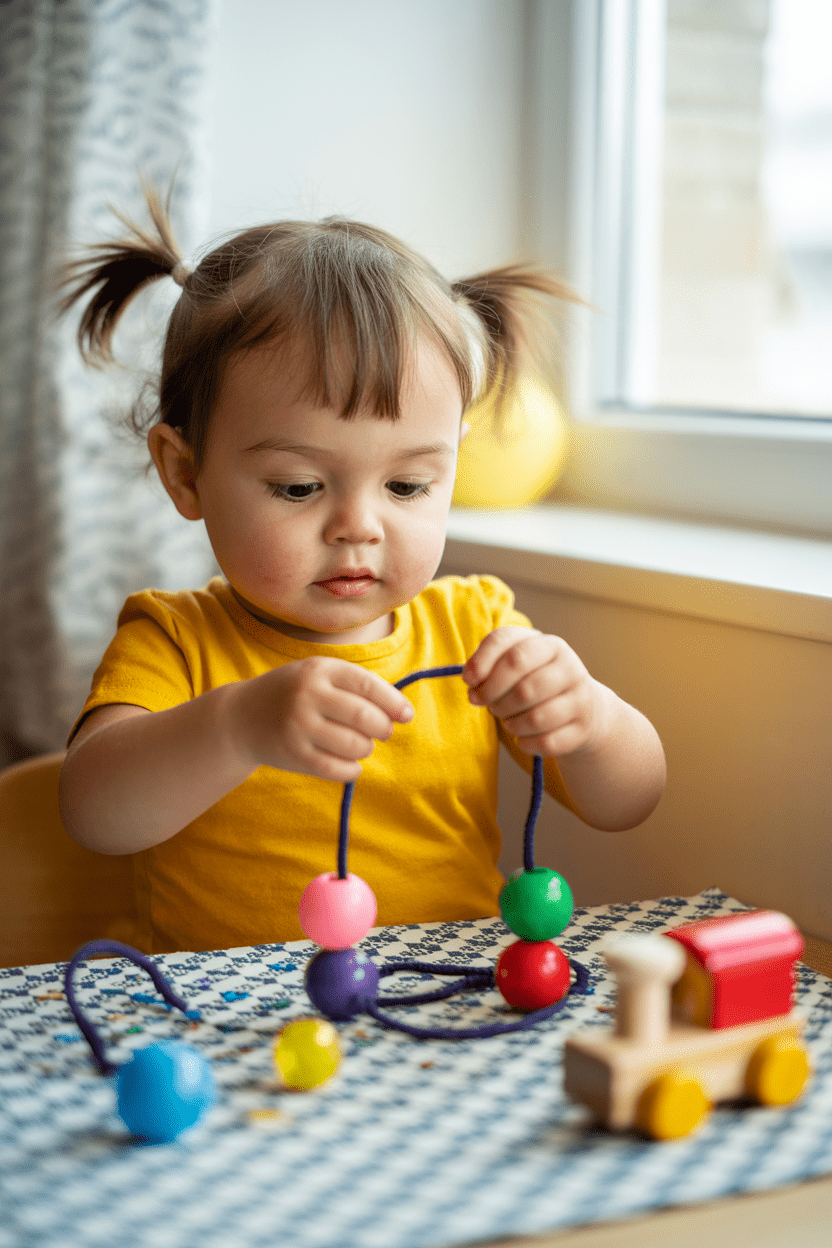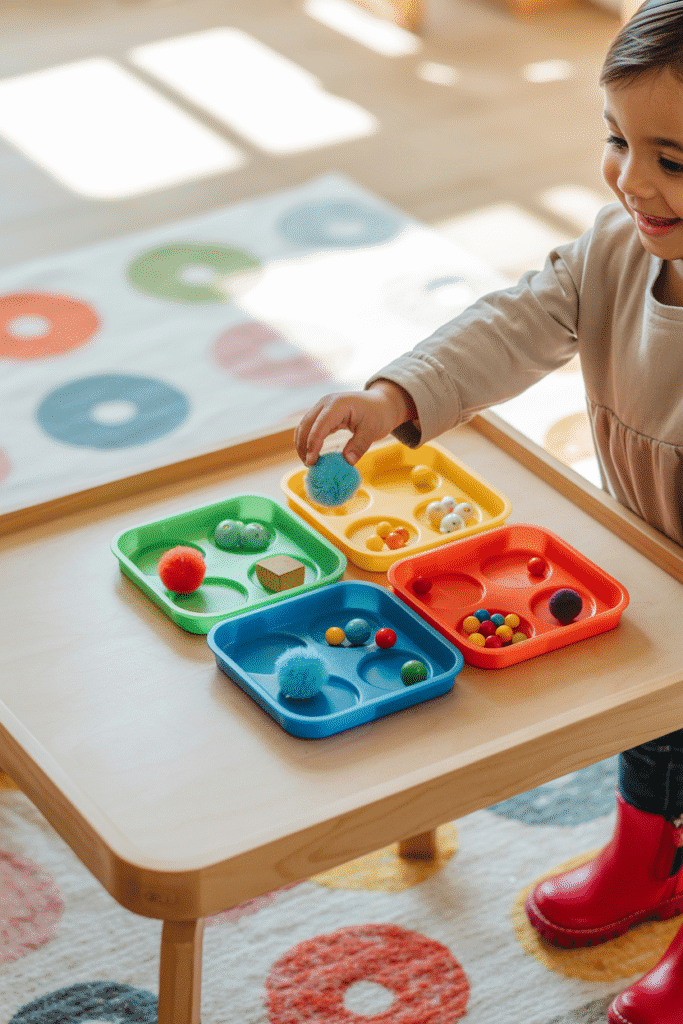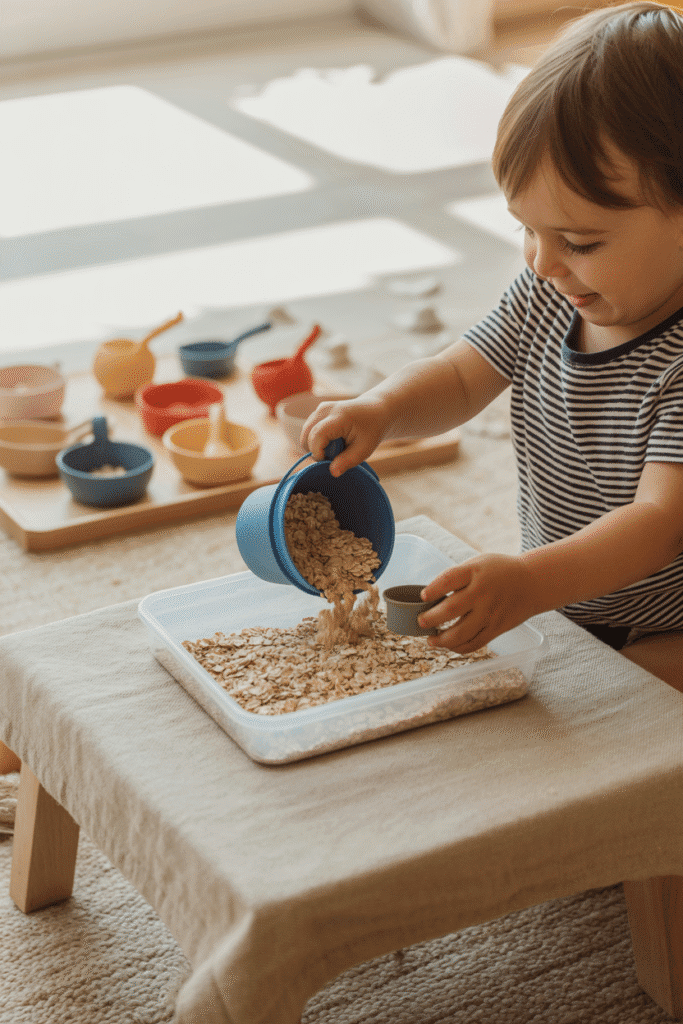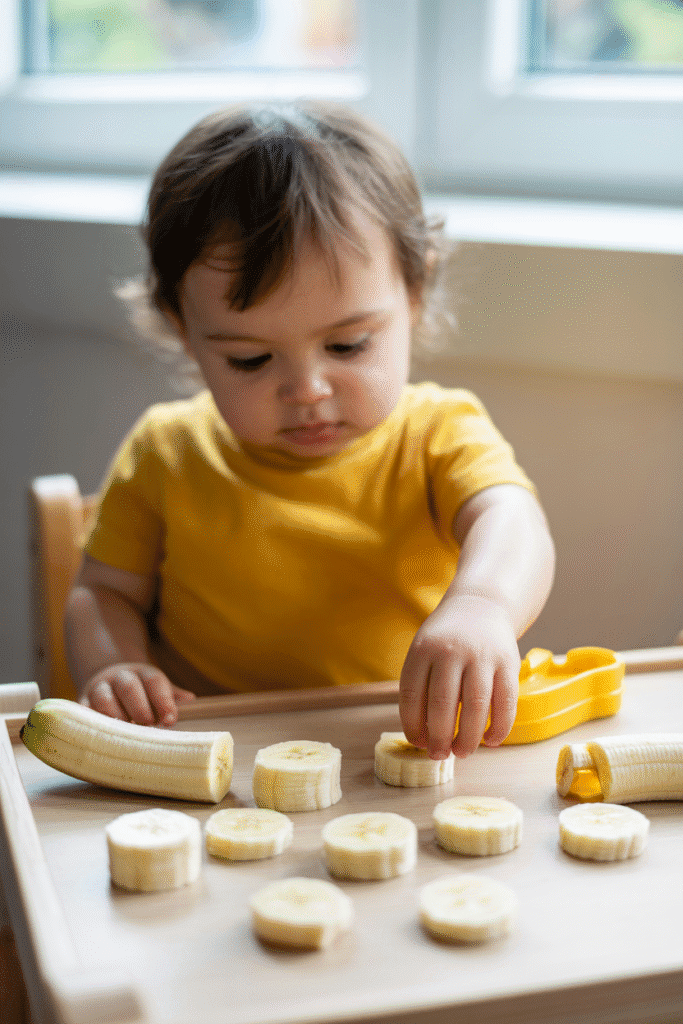
Your toddler’s hands are tiny design studios—always reaching, pinching, and “immproving” the living room styling. You want screen-free, calm-making activities that actually build skills and look cute on your feed. Same. I’ve rounded up 30 fine motor activities for toddlers that work in real life, photograph beautifully, and sneak in the good stuff: pincer grasp, hand-eye coordination, wrist stability, bilateral coordination, and early pre-writing strength. Ready for easy wins and happy hands?
The Vibe (and Why It Works)
Short setup. Reusable materials. Invitations to play that look like tiny editorials—because kids follow beauty, too. I lean Montessori-ish: low trays, natural tones, repeatable motions. And IMO, when a tray looks inviting, your toddler settles in longer. Ever watched them peel a sticker with the focus of a brain surgeon? Exactly.
1) Quick-Prep Mini Trays (5-Minute Setups)

1. Cotton-Ball Tweezers Transfer
Hook: Instant quiet + tiny giggles.
What you need:
- Tongs or tweezers, bowl of cotton balls, empty ice-cube tray
How to set it up:
- Place cotton balls in a bowl and the empty tray beside it.
- Invite your toddler to transfer one ball per cube using tongs.
Why you’ll love it: Hand strength and pincer control skyrocket. The grid layout delivers a neat visual (great photo moment).
2. Rainbow Pasta Scoop
What you need:
- Dyed dry pasta, measuring spoons, two bowls
How to set it up:
- Set pasta in one bowl and spoons between bowls.
- Scoop and pour by color or size.
Why you’ll love it: Scooping builds wrist stability; color sorting adds a calm rhythm. Pin a top-view shot—instant rainbow.
3. Sticker Lines on Painter’s Tape
What you need:
- Painter’s tape, dot stickers
How to set it up:
- Stick tape “roads” on the table.
- Challenge them to place stickers “on the road.”
Why you’ll love it: Precise finger isolation meets low mess. Bonus: tape peels off surfaces like a dream.
4. Pom-Pom Push in Spice Jars
What you need:
- Clean spice jar with holes, mini pom-poms
How to set it up:
- Place pom-poms in a dish.
- Push through the lid holes; open jar to dump and reset.
Why you’ll love it: Repetitive motion = focus. The soft pop sound is oddly satisfying.
5. Clothespin Match
What you need:
- Clothespins, paint chips or colored card
How to set it up:
- Clip pins to the matching color card edge.
- Encourage “pinch and place.”
Why you’ll love it: Clothespins beef up tripod grasp (future pencil control). It looks chic with muted tones.
6. Button Snake
What you need:
- Ribbon with a large button sewn on, felt squares with a slit
How to set it up:
- Show how to “button” felt onto ribbon.
- Let them stack a “scarf.”
Why you’ll love it: Bilateral coordination for days. Toss it in your bag for on-the-go magic.
2) Sensory Studio (Squish, Scoop, Sprinkle)
7. Oatmeal “Sand” Pouring Bar

What you need:
- Raw oats, funnels, jugs, muffin tin
How to set it up:
- Pour oats into a shallow bin.
- Add pouring tools; protect the floor (towel).
Why you’ll love it: Pouring trains steady wrists and visual tracking. Oats vacuum up easily—praise be.
8. Gel Bag Tracing Window
What you need:
- Zip bag, hair gel + food coloring, tape to a window
How to set it up:
- Fill bag with tinted gel; seal and tape.
- Invite finger paths, lines, and circles.
Why you’ll love it: Zero mess, tons of tactile feedback. Light through the window makes it Pinterest-pretty.
9. Soap Foam Car Wash
What you need:
- Hand soap + water (whip to foam), small cars, toothbrush
How to set it up:
- Set foam basin and rinse bowl.
- Scrub, rinse, park.
Why you’ll love it: Scrubbing builds grip strength; the sequence soothes. FYI: a micro towel roll-up looks adorable.
10. Playdough “Bakery”
What you need:
- Playdough, cupcake liners, toothpicks, buttons
How to set it up:
- Press “cupcake” into liners.
- Decorate with picks/buttons (supervised).
Why you’ll love it: Pinch → press → poke equals layered fine-motor practice. Soft neutrals = magazine vibes.
11. Pom-Pom Water Rescue (Tweezers)
What you need:
- Bowl of water + pom-poms, tweezers, towel
How to set it up:
- Float pom-poms; place empty tray nearby.
- “Rescue” with tweezers and squeeze dry.
Why you’ll love it: Wet textures add resistance—great hand workout. Also: dramatic rescues = big smiles.
12. Sensory Rice “Treasure Scoop”
What you need:
- Colored rice, tiny animals, scoops, colander
How to set it up:
- Hide treasures; provide scoops + colander.
- Sift and rescue.
Why you’ll love it: Sifting demands graded force control. Photograph the treasures lined up like a mini museum.
3) Kitchen Helpers (Practical Life, Big Payoff)
13. Banana “Coins” with a Safe Cutter

What you need:
- Butter knife or safe cutter, banana, small plate
How to set it up:
- Show hand on top, gentle rocking.
- Slice coins; plate them.
Why you’ll love it: Real-life skill with controlled pressure. Chef hat optional but strongly encouraged.
14. Herb Snip Station
What you need:
- Child scissors, parsley or chives, bowl
How to set it up:
- Snip into a bowl for soup/salad.
- Sprinkle at dinner like a pro.
Why you’ll love it: Scissor action fuels bilateral coordination. Toddlers glow when everyone says “Yum.”
15. Mini Spice Shakers (Smell + Sprinkle)
What you need:
- Empty spice jars, cinnamon or paprika (small amounts)
How to set it up:
- Let them smell and gently shake on hummus or toast.
- Wipe spills together.
Why you’ll love it: Smell-to-hand link boosts sensory integration; tiny shakers look chic in photos.
16. Pouring Practice with Dry Lentils
What you need:
- Lentils, tiny pitcher, three cups
How to set it up:
- Pour from pitcher to cup A, B, C.
- Return to pitcher—slow and steady.
Why you’ll love it: Pouring requires elbow control and focus; the sound is soothing.
17. Rolling Pin “Roads”
What you need:
- Rolling pin, playdough, mini cars
How to set it up:
- Roll dough roads; drive cars; reroll.
- Add “bridges” with craft sticks.
Why you’ll love it: Rolling builds wrist/forearm strength. Bonus: the tire tracks are oddly beautiful.
18. Citrus Press “Lemonade Lab”
What you need:
- Hand juicer, half lemons, water, cup
How to set it up:
- Press and rotate; watch juice pool.
- Dilute with water and sip.
Why you’ll love it: Rotation = wrist mobility gains. The proud sip at the end? 12/10.
4) Art Lab (Thread, Stick, Stamp)
19. Washi Tape Frames
What you need:
- Washi tape rolls, cardstock, photo/leaf
How to set it up:
- Tape borders around the photo/leaf.
- Trim with child scissors.
Why you’ll love it: Tape peeling trains pincer grasp; frames look gallery-ready on a clip string.
20. Dot Marker Trails
What you need:
- Dot markers, printable trails (curves, zigzags)
How to set it up:
- Place markers and one sheet at a time.
- Dot along the path.
Why you’ll love it: Dots give vertical target practice (pre-writing). Start with bold paths; narrow over time.
21. Large-Button Threading (Pipe Cleaner)
What you need:
- Large-hole buttons, pipe cleaners
How to set it up:
- Thread buttons onto pipe cleaner “bracelets.”
- Twist ends to secure.
Why you’ll love it: Stiffer than string = easier threading, still precise.
22. Playdough + Stamps “Post Office”
What you need:
- Alphabet stamps, playdough, small tray
How to set it up:
- Roll “envelopes,” stamp “letters.”
- Line them on a “mail shelf.”
Why you’ll love it: Pressing stamps builds finger strength; role play keeps it fresh.
23. Q-Tip Star Painting
What you need:
- Q-tips, paint, star outlines
How to set it up:
- Dot around the star edges, then fill.
- Offer two colors max for calm vibes.
Why you’ll love it: Q-tips mimic pencil grip; dotted edges look celestial on camera.
24. Sticker Sort in Muffin Tin
What you need:
- Stickers, muffin tin, color dots inside cups
How to set it up:
- Match sticker color to cup dot.
- Fill each “nest.”
Why you’ll love it: Sorting + in/ out motions = fine motor bliss. Also the tin compartmentalizes chaos (win).
5) Nature + Outdoors (Collect, Tinker, Arrange)
25. Leaf Hole Punch Collection
What you need:
- Single-hole punch, leaves, jar
How to set it up:
- Punch holes along leaf edges.
- Save “leaf confetti” in a jar.
Why you’ll love it: Punching works intrinsic hand muscles; the confetti is gorgeous for future crafts.
26. Pinecone Tweezers Decor
What you need:
- Pinecones, tweezers, pom-poms
How to set it up:
- Place pom-poms between pinecone scales.
- Display as table décor.
Why you’ll love it: Tiny targets = accuracy practice. It photographs like a Scandinavian holiday vignette.
27. Rock Wash & Paint Dots
What you need:
- Smooth rocks, brush, water, paint pens
How to set it up:
- Wash and dry rocks.
- Add dot patterns with pens.
Why you’ll love it: Wash → dry → dot builds sequence skills. Bowl of dotted stones = instant shelf candy.
28. Nature Threading Ring
What you need:
- Canning ring, string, leaves/flowers
How to set it up:
- Tie string across the ring like a loom.
- Weave leaves through.
Why you’ll love it: Gentle weave trains bilateral coordination; the finished wreath begs for a flat-lay.
29. Twig Rubber Band Guitar
What you need:
- Small box, rubber bands, twigs
How to set it up:
- Stretch bands over the box.
- Slide twigs under for frets.
Why you’ll love it: Stretching bands trains graded force. The twangy sound? Free soundtrack.
30. Seed Transfer with Tiny Spoon
What you need:
- Birdseed, espresso spoon, small jars
How to set it up:
- Spoon seed into jars; cap with help.
- Bring outside to feed birds.
Why you’ll love it: Spoon control polishes hand-eye precision. The bird moment adds heart.
Styling Tips (Because Pinterest)
- Tray it: Use a shallow tray or rattan placemat to frame the activity. Instant editorial.
- Limit palette: Wood, white, one accent color = calm + cohesive grid.
- Shoot top-down: Stand on a chair (carefully!) and capture those small hands in action.
- Add a sprig: A leaf, a linen napkin, a tiny jar—small props elevate the scene, not the mess.
- Caption cues: Use phrases like fine motor activities for toddlers, pincer grasp practice, Montessori tray, and busy toddler idea naturally in your pin text for search.
What’s the Learning Goal, Really?
- Pincer grasp: Stickers, pom-poms, tape edges.
- Hand strength: Clothespins, hole punch, playdough pressing.
- Wrist stability: Scooping, pouring, rolling pin.
- Bilateral coordination: Button snake, threading, scissors.
- Focus & sequencing: Wash → dry → paint, scoop → pour → reset.
Ever noticed how a simple transfer game unknots the whole afternoon vibe? That’s nervous system regulation at work, mama. FYI, ten calm minutes is a win in any timezone.
My Real-Life Notes (Tiny Humans, Honest Lessons)
I once offered four activities at once and instantly invented chaos. Now I serve one tray at a time, reset together, and put a cute jar nearby so we can “save” the best pom-poms for later. Toddlers love rituals. So do frazzled adults, tbh.
FAQ That Saves You DMs
What if my toddler throws the materials?
Start with heavier items (rocks, buttons) instead of feathers and rice. Model once, then hand over.
How long should this last?
Five to fifteen minutes is normal. Think quality reps, not marathon sessions.
Can I theme this seasonally?
Absolutely. Swap pom-poms for mini hearts in Feb, seashells in July, felt leaves in October. Easy refresh = renewed interest.
Wrap-Up (Pin, Play, Repeat)
You have 30 beautiful, no-fuss fine motor activities that build real skills and buy you a quiet cup of coffee. Lay out one tray, keep it simple, and enjoy the tiny choreography of pinch, press, pour, place. When those hands get stronger, everything else gets easier—self-feeding, zippers, crayons, and yes, fewer mealtime spoon catapults. Save your favorites, batch a few trays on Sunday, and screenshot the grid when it looks extra cute. You’ve got this, friend—stylish, smart, and totally toddler-ready.



